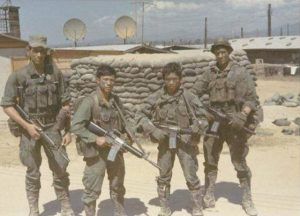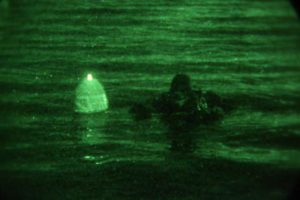As we head into February of 2024, the “wars and rumors of wars” have plateaued, for the moment: Israel’s campaign against the Hamas terror group is still grinding on; the Russian offensives against Ukraine continue to make progress, albeit slowly and painfully; the Chinese Communists are engaging in the time-honored Communist tradition of gutting their military leadership at the most inopportune times; United States and British naval forces continue to sporadically pound Houthi terrorist outposts in Yemen, although their effectiveness is somewhat in question, as the Indian Navy is engaging the occasional Somali pirate boat. Iranian mullahs continue to attempt to foment trouble around the world – no doubt helped by the $6 billion US Dollars sent to them by the Biden administration – even as the US flexes its bomber muscles in the region…And, speaking of that increasingly criminal organization, it seems to have blinked in its standoff with the US State of Texas over its criminal failure to execute the most basic of its duties under the United States Constitution – i.e., securing the US border against a literal invasion – even as it exposed itself, yet again, as holding the United States’ populace hostage to its desire to fund even more openly-criminal groups throughout the world.
In a word – things are on a low roar, at the moment. As a result, we’re going to take a look at something interesting and informative, as Freedomist/MIA doesn’t engage in the “fear-porn” popular in current media. When something develops in the arena of conflicts, we will cover it then, rather than keep terrifying you with spammy updates. That said…
Boomsticks
I usually make a conscious effort to avoid arguing for a “best rifle” (handguns are even more of a no-go in my recommendation department). Usually, I prefer to simply present you, the Reader, with a brief historical overview of a particular firearm that most people may not be familiar with, especially if the Reader might find themselves “going downrange”, in the modern vernacular.
In this case, however, I will make an exception. What follows, is strictly my own opinion – you can, of course, disagree with me…but you’ll still be wrong.
If I were forced to have only one, single “long gun” – either a rifle or a shotgun – what would that be? My answer, which has not changed in over twenty years, is the Simonov SKS rifle, and specifically, the Yugoslavian M59/66, made by Zavasta.

…..‘Wut’?
The SKS rifle was designed in 1945 by Soviet weapons designer Sergei Gavrilovich Simonov. Chambered in the M43 cartridge designed in 1944, the SKS and its derivatives are semi-automatic rifles, firing from a fixed, ten-round magazine. The M43 cartridge – despite its similar appearance – has no ‘shared history’ with the German 7.92x33mm Kurz cartridge, used in the “first assault rifle”, the Sturmgewehr-44; the M43 is measurably more powerful than the German cartridge, being functionally equal, ballistically speaking, to the venerable .30-30 Winchester cartridge (pronounced “thirty-thirty”), which dates from 1895, and remains one of the most popular hunting cartridges in the world, often in the guise of the Winchester 1894 lever-action rifle. However, the M43 is much more space-efficient, being both shorter, overall, than the .30-30, but also in that it is a rimless cartridge, as opposed to the .30-30’s rimmed case, which makes loading into a vertical magazine not impossible, but it is problematic.
The SKS magazine usually feeds from a 10-round stripper clip, but – unlike the US-designed M1 Garand – stripper clips are not required to load the magazine; loading the magazine with loose rounds is certainly slower than with a strip-clip, but is far better than the M1’s en bloc system, since without an en bloc clip in place, the M1 rifle is simply a single shot rifle.

An obvious question at this juncture would be the SKS’s relationship to the much better known AK-47 rifle. The answer is: not much. Aside from using the same cartridge, the two weapons are very different: the SKS uses a fixed (meaning, “non-detachable”) 10-shot magazine, while the AK uses detachable, 30-round box magazines. The only similarity is that the gas tubes look alike, although they function differently.
As a military weapon, originally, the SKS came with some features not usually found in civilian hunting weapons. In addition to its one-piece cleaning rod slotted under the barrel, the SKS was issued with a cleaning kit stored in its butt-stock. While this was a relatively common feature in military rifles, the SKS also featured an integral bayonet that folded around and under the barrel. While there has been a rash – yet again – of certain quarters declaring the bayonet to be dead (much like the tank), it is not, even though they are rare in the West; they are very likely more common in non-Western nations, but little in the way of technical details come out of those quarters.

Another point in the SKS’s favor is that it has a greater range than the AK-47, with an effective range roughly 100 meters longer than Kalashnikov’s rifle, due to its longer barrel – in ballistics, size really does matter, up to a point.
Finally, the Yugoslavian M59/66 version incorporates a built-in launcher for the world-standard 22mm rifle grenades, which used to be a common feature on many of the world’s military rifles.
The SKS was adopted, in some military capacity, by at least seventy nations, and usually remained in service long after those nations had switched to other weapons, such as the AK47, the M-16 or something else. The SKS, in its many variants, can be found on battlefields around the world, to this day.

So – after the above information, why would this be the rifle I would pick, if I could only have one rifle?
First, it checks the widest number of boxes: it is fully capable as a hunting rifle for virtually any game I would consider hunting; I have neither plans nor desires to go hunting for bears or moose…and were I to run into either – that’s why I have ten rounds.
Next, it is semi-automatic in operation. This is a real point, because as a semi-automatic, it automatically extracts, ejects and chambers a new cartridge on its own, until the magazine is empty. With other weapons, including lever-actions like the Winchester ’94, or bolt-actions like the Mauser, Enfield, Mosin-Nagant, Carcano, etc., manually working the action usually involves breaking the shooter’s grip on the rifle, forcing them to realigned their eyes to the sights. Semi-automatics like the SKS and M1 Garand eliminate this issue.
Next, is its cartridge. While any gaggle of shooters will argue endlessly over the merits of “this cartridge vs that”, no one can dispute the effectiveness of the M43 round, now over 75 years old, in both hunting and combat, and its ammunition is relatively common and “cheap-ish” for civilian buyers in the US to lay hands on (at least at the moment). While its range may not be the longest, 400 meters is perfectly sufficient for most uses. Then, there is its sheer simplicity: there are not that many parts to deal with when you need to take it apart, and none of those are particularly small, or easy to lose.

That pretty much sums up the civilian hunting – and “SHTF” (S*** Hits The Fan) – side of why this would be my go-to.
The other side, obviously, is whether it is still an effective weapon for “military-type” use. True, it is not selective-fire, as modern military rifles are. And, yes, it has “only” a ten-round magazine, versus the 30-round detachable magazines that modern military rifles use. And realistically, do you really need the extra weight of a bayonet, much less a grenade launcher?
So, let’s address the above questions.
First, selective fire rifles (i.e., rifles that can fire in the fully-automatic mode, similar to an actual machine gun) has long been understood to be virtually useless in individual combat rifles – outside of very narrow circumstances – because rifles are too lightweight to lay a predictable pattern of fire, which is what actual machine guns are designed for…“Fully Automatic Machine Gun Fun” is, well, fun, but that’s usually all it is.
Second, is the magazine. If the Reader were to buy, say, an AR-15 or a civilian-legal AK-47, each of those 30-round detachable magazines will run anywhere from (as of early 2024) $9 – $25, each, depending on what you’re buying…and you’re going to need at least three to five of them, because even just going to the range will get very annoying, very fast, if you only have one or two magazines. In contrast, the SKS’s 10-round stripper clips can be reloaded with commercial ammunition if you save the clips, and you can buy military surplus ammunition that comes in sealed “Spam-Cans”, with all of the rounds factory-loaded onto stripper clips.
There is also the relentless controversy over the dreaded “magazine spring ‘taking a set’” – the notion that leaving magazines stored fully loaded for too long will weaken their internal springs over time. Personally, I’ve never had this happen, but I can see the other side of the argument…all of which is irrelevant with the SKS: if its magazine spring is sticking or is weak – replace it.
Because of this, you can load whatever type of field rig you prefer with SKS stripper clips, and they will sit there happily and patiently, waiting for you to use them, until they are so old, they are corroding their cases.
As to the grenade launcher and bayonet? Well – I certainly hope that I never need to use either of those two features; if that has happened, world civilization has collapsed, and all bets will really be off…But, in the unlikely event that the world has been reduced to that state, I would far prefer to have those feature and not need them, than to need them and have them.
The SKS: You need Simonov’s simple rifle…just, please – don’t “Bubbify” it with Tapco gear.
Trust me, there.







